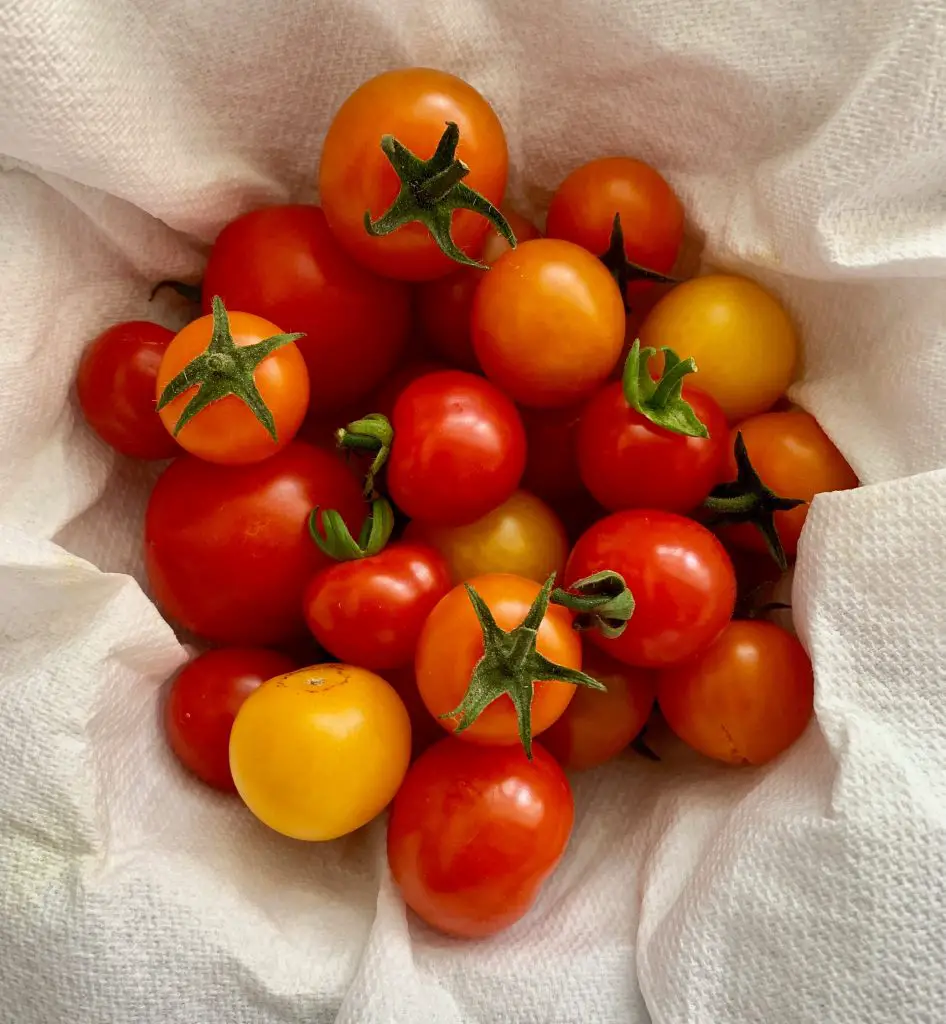Can You Plant Tomato Seeds Directly In The Ground? One of the most common questions people ask is if can they plant tomato seeds directly in the ground. Tomato seeds are typically planted at the end of February or beginning of March, and this is usually done indoors particularly in cooler regions. However, it may be tempting to skip this step and just plant right out of the packet in the soil. But will this work?
It is possible to plant tomatoes seeds directly into the ground provided that any risk of frost has passed. However, to increase the speed of germination and success rate it is advisable to provide some protection to seeds in the form of a cloche row cover or even a cold frame.
Any protection applied to the tomatoes seeds will increase the temperature of the surrounding soil which will accelerate the growth rate. However, while it is possible to germinate tomato seed in the garden the reason why it is done in trays is that there are some distinct advantages associated with planting in seed trays.
What Is The Advantage Of Planting Tomatoes Seeds In Seed Trays?
The main reason why people generally plant tomatoes into seed trays is that it allows the gardeners to easily control the growing conditions. This factor has several associated benefits which will improve the productivity of your tomato plant as well as your garden generally.
The reason for this is that seeds can be started off earlier in the season when it is still cold outside. This has two benefits, the first is that it extends the time that the tomato plant has to develop its fruit.
This can be important if you live in an area where the growing season is relatively short. In these colder climates, this can significantly affect the volume of the fruit, as most tomatoes take some time to really get going. The initial harvesst can be quite small but the additional of a few weeks of plant development can make a world of difference.
The second key benefit is that the temperatures of the soil are generally much warmer which increases the growth rate significantly leading to higher overall yield during the season.
Other factor that can cause issues in the garden is if you are using home made compost as it will often contain tomato seeds which can pop up unexpectedly. This can cause problems because young tomato plants look the same irrespective of the variety, so you might end up growing seeds from supermarket hybrid tomatoes which are not the best flavor.

What Happens If You Plant Tomatoes Too Early?
If you plant tomatoes too early in seed trays there is usually not much of a problem. The reason for this is that if they out grow the seed trays before the weather improves they can be put into a larger pot. The plants will generally not grow as well as those plants in late spring or at the height of summer due to the lack of light but they will survive.
However, if you plant tomatoes too early when sowing outdoor there is a pretty good chance that the plants will not survive. The reason for this is that most places around the world, as they come out of the winter, have variable weather. There can be warm days followed by cold nights where a frost is produced.
In these conditions the warmer spells during the day can trigger germination of the plants. Once these seedling emerge they then become susceptible to frosts which will result in the plants being most likely dying. As such it is critical to ensure that the seeds are sown after any risk of frost has passed.
If you are planting tomato seeds directly I would rush too much as even if the seeds germinate in relatively cool temperatures they will be slow to get going. Seed planted at a later date will often catch up. The absolution minimum soil temperature that seeds will germinate at is 50F (10C) and temperatures above that are generally recommended.
However, a cloche, cold frame or row cover can be used to protect the plant from the cold and wind. Our recommendations for these things are provided in the how to grow tomatoes section of the article.

What Happens If You Plant Tomatoes Too Late?
If you plant tomato seeds too late in the summer heat can prevent the seeds from germinating or more likely there is insufficient time for the plants to develop fruit. As most tomato varieties take between 100 to 120 days to produce their first fruits you can pretty much calculate the last date that the seeds can be planted by knowing the first expected frost date in your location.
Subtract 150 days from the last frost date to calculate the last day that you can plant. The addition of 30 days is added because it will take a month or so to get a reasonable number of fruit. If you are really pushing your luck try planting cherry tomatoes rather than slicing tomatoes as they often fruit alittle quicker.
To learn more about the different tomato varieties available try visiting our vegetable database which contains additional information on the days to harvest for a range of tomatoes.
If you need to purchase seeds I would suggest visiting seeds now as they have a wide range of seeds that are significantly cheaper than other retailers.
The Steps You Should Take If You Are Planting Tomato Seeds Directly
If you decide to plant tomato seeds directly, you can take a few important steps.
- Choose the right place for planting – make sure that the place you have chosen has well-drained soil and receives plenty of sunlight. At the beginning of the season, you need to think in advance to avoid a place that is shaded by the leaves of trees later in the season.
- Add a little compost to the soil – this improves the structure of the soil and allows the soil to retain some water without getting wet. Compost also provides plants with nutrients.
- Wait for the warm weather – the soil temperature must constantly exceed 50F (10C)
- Provide the seedlings with protection
How To Grow Tomatoes
Tomato plants are relatively easy to grow, but they require some care to maximize yield. Tomatoes prefer a warm climate and are prone to frost damage, which means that most gardeners begin to plant them in the spring after the last frosts.
Seeds can be planted directly in the garden as mentioned above, but most people tend to plant the seeds in trays. The ideal time to sow the seeds, if the seed container is kept inside, is about 4 to 6 weeks before the last frost.
Planting Tomato Seeds
When planting tomato seeds in trays, start filling the seeds with a seed-growing mixture, which you can buy at the local garden center or online on Amazon. Although garden soil can be used to germinate seeds, I recommend using seed raising mix, as it is sterile and does not contain weed seeds that can compete with tomatoes. Seeds should be sown to a depth of about 0.5 inches (1 cm) for one seed per cell.
When determining the number of seeds to sow, it is best to plant about 50% more seeds than you actually want. This ensures that you end up with the desired number of plants in the garden as young seedlings can sometimes be destroyed by snails and slugs.
After sowing the seeds, it is important to keep the soil moist. Seedlings will emerge after 7 to 10 days and will usually need to spend a total of 6 weeks in seed trays before being planted outdoors.
If you are planting early in the season, particularly in colder regions I recommend using a heated propagation tray as they provide ideal conditions for germination of seeds and are not too expensive to purchase.
What we recommend is the IPower heated seed germination mainly because it has a ventilated moisture dome and is relatively inexpensive. Click on the link to see the current price on Amazon.

Planting Seedlings in the Garden
When the seedlings are about six weeks old they need to be planted at a spacing of 2 to 3 ft (60 to 90cm). The planting location should be warm and sunny and have rich moist soil with free drainage. If your soil is lacking nutrients it is recommended that you add a bag of compost to the soil.
If you live in a location where the weather is inconsistent it is recommended to cover the plant with a cloche or row cover. Cloches can be made from 2 or 3 liters of plastic milk cartons by removing the bottom of the carton with a knife, but because they are relatively short, the time that the plant can be grown inside is very limited.
However, if you live in a cooler area, it is worth getting coverage for a larger number of plants that is generally taller. For this we recommend using the Growsun row cover because it is relatively long hoops that can be fixed deep into the ground, making it resistant to wind.
Caring For Tomatoes
The tomato plant will need a support structure as it gets larger. This is traditionally this is done using a single tomato stake per tomato which I find is difficult to support all of the tomato vines as it matures. I prefer to use a mesh structure or trellis for tomatoes because it has several points to which the plant can be attached which is important since tomato plants usually produce more than one stem.
However, to prevent the plant from turning into a confusing mess, it is necessary to limit the number of stems from 1 to 3 and regularly tighten the side shoots. Side shoots start from the main trunk at a 45-degree angle between the main trunk and the existing branch. To learn more about managing tomato plants, click here.
Once the tomatoes begin to mature they will produce small yellow flowers which are soon followed by small green fruits. These fruits will grow in size, and then they will begin to change color, at which point they will be ready to be picked. Tomatoes will continue to bear fruit throughout the season until the arrival of frost.
To increase the volume of ripe fruits that can be harvested, it is recommended to remove the top of the plant about 4 weeks before the arrival of the first frosts. The removal of the upper part of the plant will stimulate the plant to concentrate its energy on the ripening of the existing fruits. When the frosts hit, it is recommended to uproot the plant and remove all the green fruits.
Some of these green fruits will ripen inside provided that they are not too small and immature. It is common for people to put green tomatoes on the window ceils to encourage them to ripen. However, if they are going to ripen they will do so whether they are placed in a bright sunny location or not. The ripening process can be accelerated by placing the tomatoes near an ethylene-producing fruit.
Related Articles
Are Grafted Tomatoes Really Worth The Money?
What is the Difference between a Determinate or Indeterminate Tomato?
Do You Need To Prune Indeterminate Tomatoes?
How Many Tomatoes Can You Get From One Plant?
Why Do Cherry Tomatoes Taste Better Than Regular Tomatoes?
How Can You Tell If A Tomato Flower Is Male Or Female? And How To Hand Pollinate Them.
Is It Too Late To Plant Tomatoes? And How To Make The Most Of Summer

